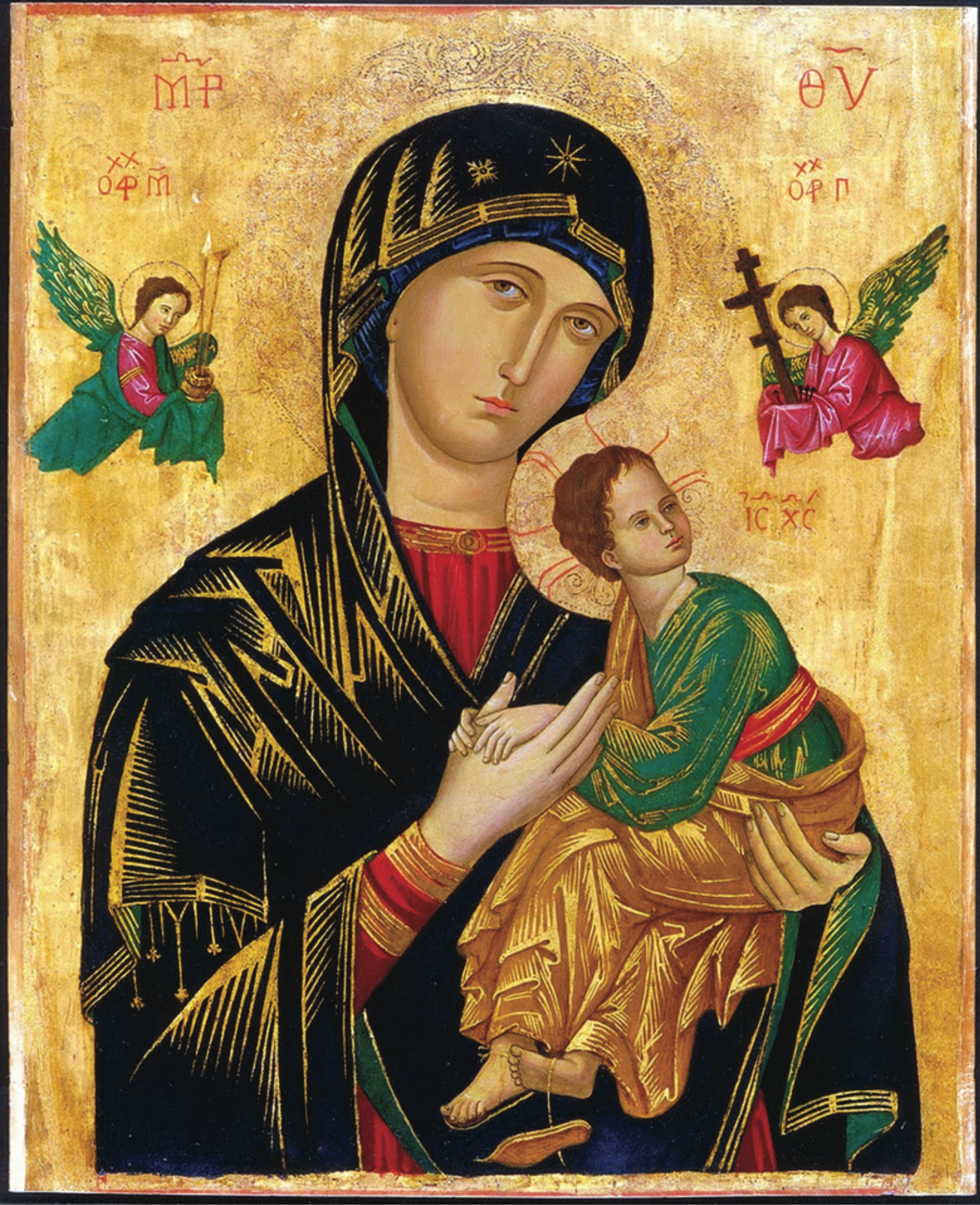
Icon of Our Lady of Perpetual Help in the Church of St. Alphonsus in Rome
“The greatest saints, those richest in grace and virtue, will be the most assiduous in praying to the most Blessed Virgin, looking up to her as the perfect model to imitate and as a powerful helper to assist them.” Saint Louis Marie de Montfort
This year marks the 150th anniversary of the Icon of Our Mother of Perpetual Help being restored to public veneration by Pope Blessed Pius IX (1846-February 7, 1878). In December of 1865, after commending the icon to the Congregation of the Most Holy Redeemer (i.e., the Redemptorists), Pius gave the superior general of the order the following charge: “Make her known throughout the world!”
In memory of this event, Pope Francis has recently declared a Jubilee Celebration to honor this image of Our Lady. Furthermore, a plenary indulgence has been granted to those who make a pilgrimage to venerate the icon between June 27, 2015 and June 27, 2016: “The Apostolic Penitentiary, by mandate of Our Holy Father Francis, willingly grants a Jubilee Year with the associated Plenary Indulgence, granted under the usual conditions (sacramental confession, Eucharistic Communion and prayers for the intentions of the Supreme Pontiff) to be gained in the Church of St. Alphonsus in the City of Rome and in the individual Churches of the Congregation of the Most Holy Redeemer, by the Christian faithful who are truly penitent and moved by charity, make a pilgrimage to the icon of Blessed Virgin Mary of Perpetual Help and there devoutly take part in the properly configured jubilee rites, or at least spend a suitable time in pious reflections, concluding with the Lord’s Prayer, the Creed and invocations of the Blessed Virgin Mary.”
With the inauguration of this Jubilee, Pope Francis is drawing our attention to a very remarkable devotion to the Mother of Christ. This devotion, moreover, is somewhat unique as it is based on a single work of art. Though the story of how the icon came to be an object of veneration is somewhat shrouded in mystery, the story which the icon itself depicts is nonetheless “full of grace and truth” (Jn 1:14).
The Icon Narrative
This icon depicts the climax of a rather touching story. According to pious legend, one day the Christ Child was walking alone when suddenly two angels appeared to him. The apparition was of a prophetic nature, for both angels carried the future instruments of his passion.
Sent as a reminder of the ignominious fate he would one day face, the boy Jesus became frightened. Perhaps this fear was a foretaste of what he would one day experience on the Mount of Olives. Here, however, instead of turning to his Father as he did in Gethsemane, he turned to his mother.
Christ ran to her arms to comfort and console him. It is at this moment of embrace between the Madonna and Child that the icon radiates the beauty of their love and unfolds its message.
The Two Angels
While Mary caresses her son in the foreground, two angels hover behind. These angels — from the Greek word meaning “messengers” — are none other than the two archangels Michael and Gabriel. Michael is on the left and Gabriel on the right, both being identified by the Greek abbreviation of their names.
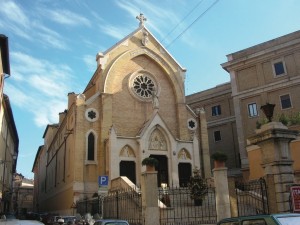
The exterior of the Church of St. Alphonsus in Rome
Michael is an important figure in Judaism, being mentioned several times in the Book of Daniel (cf. Dan 10:12-13; 12:1). He is also referenced twice in the New Testament, both times as an adversary to the devil: “Now war arose in heaven, Michael and his angels fighting against the dragon; and the dragon and his angels fought, but they were defeated and there was no longer any place for them in heaven” (Rev 12:7-8; cf. Jud 1:9). These verses refer to a popular story in Christian tradition in which Michael, the commander of the heavenly hosts, triumphed over Satan and his fallen angels. When Lucifer uttered his cry, “I will not serve,” it was Michael who in loyalty to the Almighty asked, “Who is like God?” — which phrase became his very name, for in Hebrew Micha’el means “Who is like God?”
In commemoration of this victory, Michael is commonly depicted as a legionary carrying a spear. In this icon he is depicted likewise; however, here he holds two spears. The first spear is that which holds the sponge of bitter wine which Christ will drink on the cross (cf. Mt 27:34); the other is that which will pierce his side (cf. John 19:34).
And yet, with these two spears, one cannot but think further of the twofold piercing of the mother and child prophesied by Simeon: “Behold, this child is set for the fall and rising of many in Israel, and for a sign that is spoken against, and a sword will pierce through your own soul also, that thoughts out of many hearts may be revealed” (Lk 2:34-35). In addition to these weapons, Michael, a heavenly soldier, holds the crown of thorns which one day a Roman soldier will place upon the head of Christ.
Gabriel is likewise an important angel in the Jewish and Christian faiths. Though he is mentioned in the Old Testament (cf. Dan 8-9), he is most prominent in the Gospel of St. Luke, where he serves as God’s messenger in preparation for the Incarnation: “I am Gabriel, who stand in the presence of God; and I was sent to speak to you, and to bring you this good news” (Lk 1:19).
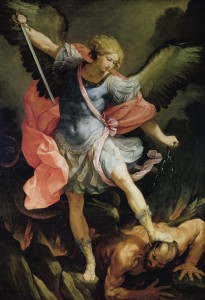
Below, the Archangel Michael defeats the devil in the famous painting by Guido Reni
Gabriel is furthermore an especially Marian figure, for it was he who declared to the Virgin of Nazareth that she would be the Mother of God: “And the angel said to her, ‘Do not be afraid, Mary, for you have found favor with God. And behold, you will conceive in your womb and bear a son, and you shall call his name Jesus’” (Lk 1:30-31). He is the first to announce that the name of the Messiah is Yeshua, which means “Yahweh saves.” Here in the icon Gabriel presents the instruments by which “Yahweh saves”: the cross and the nails of crucifixion.
The Virgin Mother
As she is often depicted, Mary is wearing a mantle of blue. This shows her high status, for vested in this royal color, she reigns as queen of the heavens whose blue canopy covers the earth.
On her mantle, moreover, a star is placed. This is an allusion to her famous title Maris Stella, “Star of the Sea.” For, when the night is black and all hope seems lost, she is the brilliant glimmer radiating hope and encouragement to those in darkness. One of the most beautiful features of this image is the hands of the Blessed Mother. With the left, she is holding the Child up and drawing him to herself; with the right, she embraces the hands of God who clings to his mother. In this embrace she shows steadfast strength. One cannot but cherish this moment of tender affection. For presently he hangs in her arms; one day he will hang from a cross. Yet in both circumstances she is there to offer compassion and constancy.
But the most striking aspect of the Virgin is her visage. Here, tenderness and resoluteness meet. Her face of conviction which she turns to her Child is the same face she will lift to him on Calvary. In both instances, she suffers with her son but all the while surrenders willingly to the loving plan of redemption: “For God so loved the world that he gave his only Son, that whoever believes in him should not perish but have eternal life” (Jn 3:16). Mary will not challenge the Father’s will; on the contrary, she strengthens the Son to fulfill his soteriological destiny.
The Christ Child
The figure of Jesus is remarkable. His garments and proportion evince a man; his size and posture, a babe. The former depicts his divine attributes such as wisdom and omniscience; the latter reveals his humanity in all its frailty and weakness.
Here is the God “who, though he was in the form of God, did not count equality with God a thing to be grasped, but emptied himself, taking the form of a servant, being born in the likeness of men” (Phil 2:6-7). In the child we see a portrait of the very mystery of the hypostatic union.
Furthermore, Christ’s body language is moving. He clings to Mary’s soft hands and reclines on her for strength all the while looking to the right where Gabriel holds the cross. Though he leans on his mother for support, in his face is the hidden determination to fulfill the purpose of his human life.

In a work by Luca Giordano, the Archangel Gabriel announces to Mary that she shall bear a son
We see but a glimpse of the Son who will one day lay down his life in obedience to the Father: “Now is my soul troubled. And what shall I say? ‘Father, save me from this hour’? No, for this purpose I have come to this hour. Father, glorify thy name” (Jn 12:27-28).
Of all these details and subtleties, however, the most touching is the unshod foot of the Child.
At the base of his right leg a broken sandal hangs ready to fall. It is the only evidence of the violent sprint in which he fled the angels and leapt into his mother’s arms.
And here is a great lesson of the icon: let us follow the example of Christ and run to our mother in all our necessities. Whether it is fear, anxiety, sorrow, or distress, let us remember the message given to Juan Diego at Tepayac: “Am I not here who am your mother?”
Ultimately, this icon, in prefiguring the crucifixion, also prefigures the precious gift we all received from the cross: “Behold your mother” (Jn 19:27). Let us never forget this clement queen, this mighty intercessor, this tender mother; rather, as St. Francis de Sales explains, “Let us run to Mary, and, as her little children, cast ourselves into her arms with a perfect confidence.”
The New Evangelization
And yet the message of this icon can be taken even further. Perhaps, Mary is not just presented for our consolation, but also for inspiration, even imitation. “Faith apart from works is dead,” St. James wrote to the early Christians. In a similar vein, Our Lady’s eyes look out from the painting towards all the faithful as she echoes the plea of St. Paul: “Be imitators of me” (1 Cor 4:16).
This model of Mary is precisely what Pope Francis has placed before the Church for reflection. In fact, in his Apostolic Exhortation Evangelii Gaudium, the Holy Father called the Blessed Mother the “Star of the New Evangelization.” For it is in turning to her that we will find our guide and our strength in spreading the Gospel message with joy: “Whenever we look to Mary, we come to believe once again in the revolutionary nature of love and tenderness… She constantly contemplates the mystery of God in our world, in human history and in our daily lives. She is the woman of prayer and work in Nazareth, and she is also Our Lady of Help, who sets out from her town ‘with haste’ (Lk 1:39) to be of service to others” (EG 288).
This title of “Our Lady of Help” underscores the very essence of the New Evangelization. As soon as Mary had conceived the Christ Child, she did not remain in hidden contemplation nor avoid contact with others, but on the contrary went hurriedly “into the hill country” to help her pregnant cousin Elizabeth (cf. Lk 1:39-40).
Such an example of apostolic charity is precisely what Christians in recent years have been asked to emulate.
Having received Jesus, we must not hide our joy: “No one after lighting a lamp puts it in a cellar or under a bushel, but on a stand, that those who enter may see the light” (Lk 11:33). Nor are we to rest on our endowment: “You received without pay; give without pay” (Mt 10:8).
Therefore, Mary going to the aid of one in need is our model par excellence. What better image for the New Evangelization.
Let us turn to her with confidence and answer the call to re- evangelize the world, an exhortation which John Paul II, Benedict XVI, and now Francis have given to all the faithful.


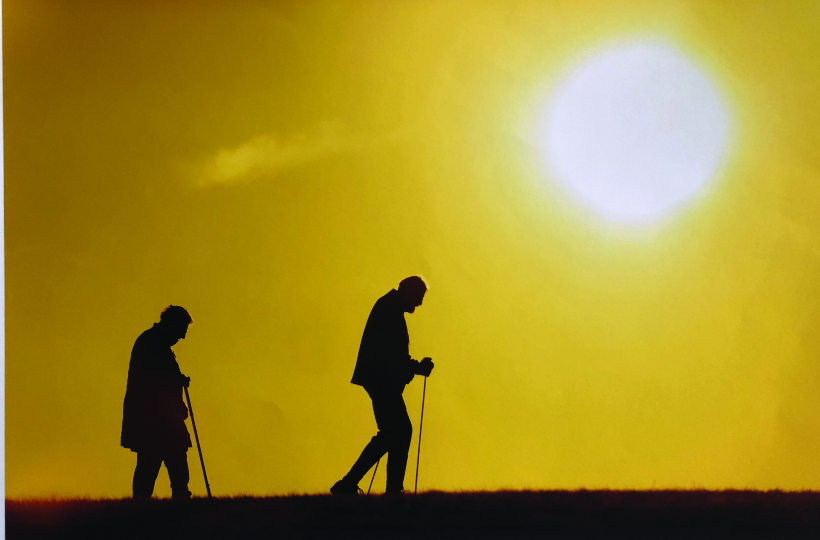
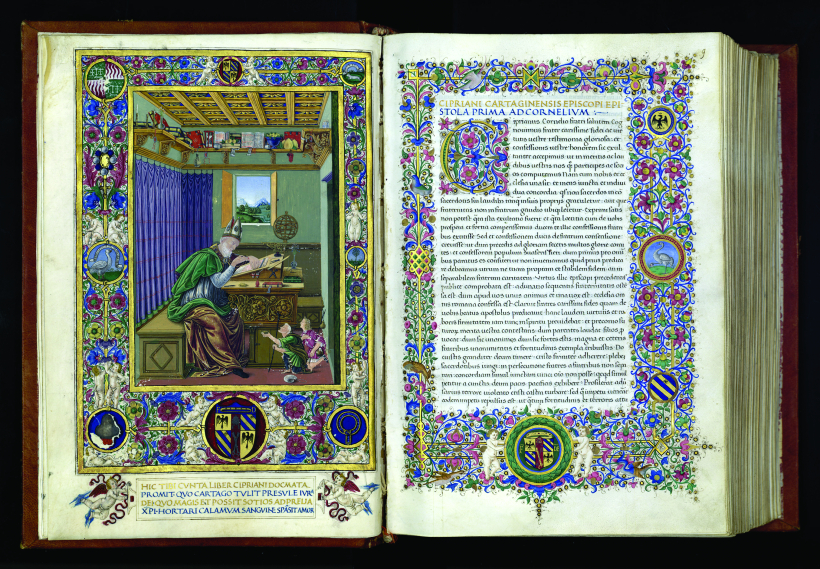
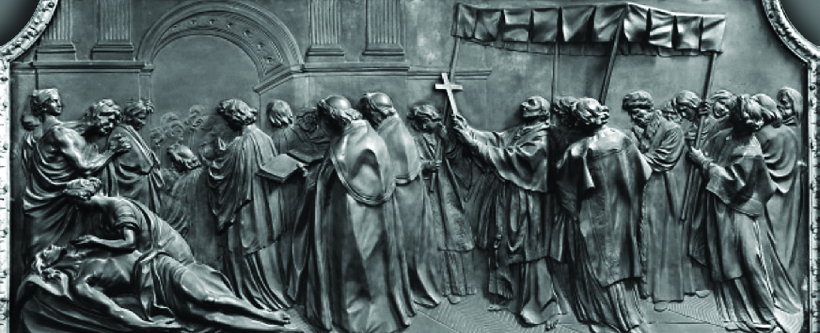
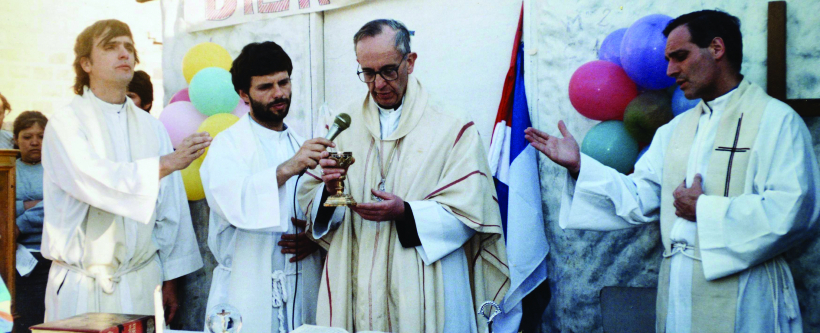
Facebook Comments